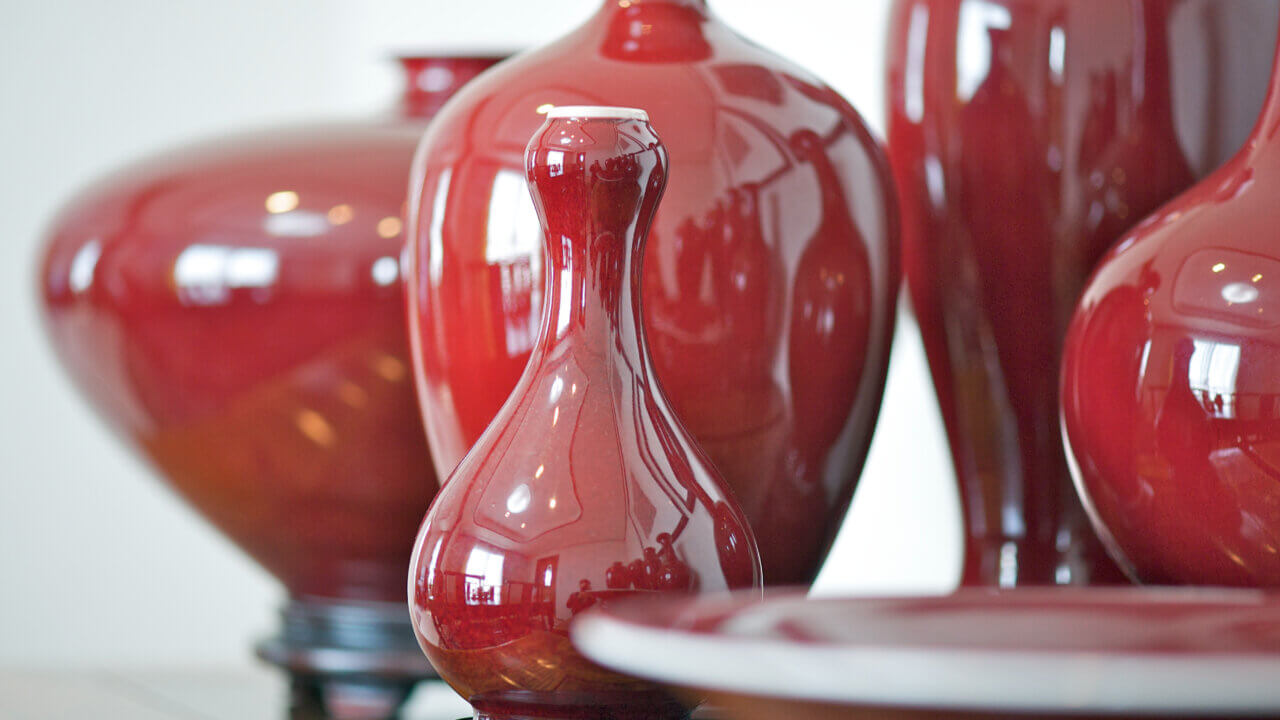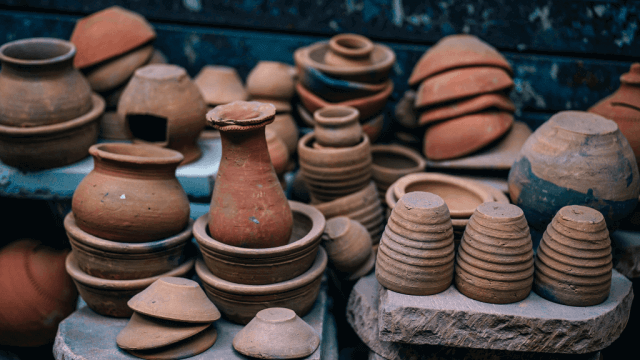Pottery glaze is a glass-like coating applied to pottery surfaces for decoration and protection. It is made from various materials, including minerals, colorants, and flux, mixed with water to create a liquid mixture. Once applied to the pottery and fired in a kiln, the glaze undergoes a chemical reaction, melting and hardening to form a durable, smooth, and glossy finish.
Defining Pottery Glaze
Pottery glaze is a glass-like substance applied to the surfaces of ceramics to enhance their aesthetics, add color, and provide protection. Composed of minerals, colorants, and flux agents mixed with water, the glaze transforms into a durable, glossy finish after firing in a kiln.
Glaze Components and Applications
Minerals and Colorants
Glazes derive their color from various metal oxides, such as cobalt (blue), copper (green), or iron (brown). Other minerals like feldspar and silica supply essential properties for the glaze, creating chemical stability and transparency.
Flux Agents
Flux agents, like boron or lead, are crucial for lowering the melting point of the minerals in the glaze, allowing it to adhere and form a durable bond with the pottery during the firing process.
Glaze Application Techniques
Several methods for applying glazes include dipping, brushing, pouring, and spraying. These techniques achieve different surface effects and allow for color, pattern, and texture experimentation.
Glaze Firing Process
Once the glaze has been applied, the pottery is fired in a kiln. During firing, the glaze undergoes vitrification, which melts, fuses with the ceramic body, and solidifies into a glassy surface. The temperature and duration of firing significantly impact the final appearance and properties of the glaze, and experimenting with these variables allows artists to develop unique and vibrant finishes.
Types of Pottery Glazes
Glossy Glaze
Glossy glazes are the most common type, providing a smooth, reflective surface. The glossiness results from a higher proportion of flux in the glaze mixture, melting it more readily during firing.
Matte Glaze
Matte glazes have a less reflective, flat finish resulting from lower flux and higher clay content, creating a more textured surface. This effect can be used to emphasize the form and details of a piece.
Crystalline Glaze
Crystalline glazes feature intricate patterns of crystalline growth formed during the cooling process in the kiln. These glazes require precise firing conditions and well-controlled cooling rates to achieve their unique appearance.
Safety Considerations for Pottery Glazes
When working with pottery glazes, it’s important to be aware of potential health risks. Some glaze ingredients, such as lead and other heavy metals, can be toxic when inhaled or ingested. Always follow safety precautions when handling raw materials and ensure proper ventilation when applying and firing glazes. Additionally, choosing lead-free and food-safe glazes helps protect both the artist and the end-user.
Variations in Glaze Surface Effects
Pottery glazes exhibit a wide range of surface effects that depend on the composition of the glaze and the firing process. These effects contribute to the uniqueness of each glazed piece and offer endless possibilities for creativity. Some examples include:
Opaque Glaze
Opaque glazes are not see-through and completely cover the underlying pottery. They can be useful for hiding imperfections on the ceramic surface and create a bold, uniform finish.
Transparent Glaze
Transparent glazes allow the underlying clay body or decoration, like slips or underglazes, to show through. They are typically used when the artist wants to emphasize surface designs, carving, or texture.
Celadon Glaze
Celadon glazes are a specific type of translucent glaze, known for their soft green color. They originated in China, and their subtle beauty has made them highly prized throughout history.
Glaze Compatibility
Not all pottery glazes are suitable for every type of clay body or firing temperature. It is vital to match the glaze appropriately to the underlying clay, and understand the firing requirements to achieve the desired result and avoid potential flaws or damage to the pottery. Testing small samples before applying the glaze to a finished piece can help ensure compatibility and achieve the desired effects.
Frequently Asked Questions About Pottery Glazes
In this section, we address some of the most common questions that arise when exploring pottery glazes, from their composition to techniques and compatibility issues. Our objective is to help guide both beginners and experienced potters towards a better understanding of glazing in pottery.
Can I create my own pottery glaze?
Yes, you can create your own pottery glaze by mixing the appropriate minerals, colorants, and flux agents with water to achieve the desired consistency and color. Recipes for various glazes are available in pottery books and online resources. However, be prepared to experiment and test your glazes, as different clay bodies, firing temperatures, and application methods can affect the final results.
How do I fix pottery glaze flaws?
Pottery glaze flaws, such as pinholes, crawling, or crazing, can occur due to various factors, including glaze thickness, clay body, or firing process. To fix these flaws, you may need to adjust the glaze recipe, application method, drying time, or firing temperature. It is essential to identify the cause of the flaw and test adjustments on small samples before reapplying them to finished pieces.
Can I mix pottery glazes?
It is possible to mix pottery glazes to create new colors and effects, although the outcome can be unpredictable. To achieve the best results, it is essential to understand the composition of each glaze, their compatibility with one another, and their firing requirements. Experimenting with small test samples before applying the mixed glaze to a finished piece will help ensure satisfactory results.
Can all pottery glazes be used for food-safe ceramics?
Not all pottery glazes are suitable for food-safe ceramics. Some glazes contain toxic materials, like lead or other heavy metals, that can leach into food or drink. When creating functional ceramics, choose food-safe and lead-free glazes explicitly formulated for this purpose. Always follow guidelines and proper firing procedures to ensure the glazed piece is safe for use with food.
How can I remove an unwanted glaze from my pottery?
If you need to remove a glaze from your pottery, you can carefully use a tool like a scraper, sponge, or sandpaper to remove the surface layer. It may not be possible to remove all traces of the glaze, and some remnants may still be visible after refiring. However, this method can be helpful in correcting small flaws or adjusting the surface before applying a new glaze.











